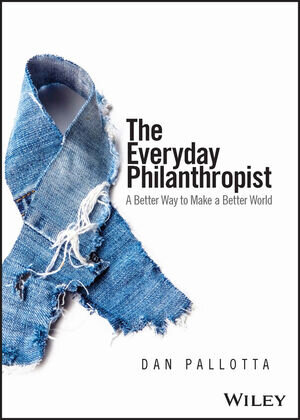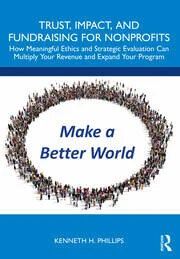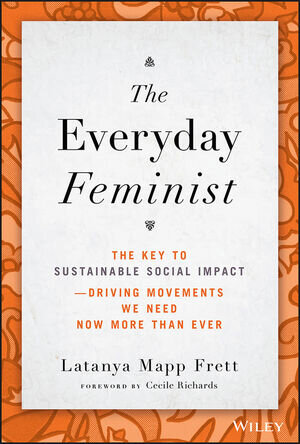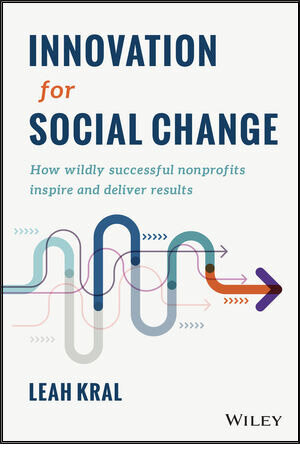The Everyday Philanthropist: A Better Way to Make a Better World
When I was in college, a teaching assistant who helped us ask for help once said, “Ask the professor to explain it to you as if you were five.” That rang through my head while reading this field guide. Dan Pallotta walks the reader through how to approach giving and philanthropy in the simplest way.
In under 200 pages, the latest edition of The Everyday Philanthropist: A Better Way to Make a Better World boils down the high points of Pallotta’s first book, Uncharitable: How Restraints on Nonprofits Undermine Their Potential, and his TED talk “The way we think about charity is dead wrong.” He consistently drives home the point that we need to look past and deconstruct the idea of “overhead” and what can be perceived as back-end spending by charities. With infographics scattered throughout, the book makes constant comparisons to the for-profit sector, or a world where overhead isn’t so constrained. The reader gets actual illustrations of what charitable impacts look like when keeping overhead low isn’t the main priority.
Part one focuses on the basics and reads like a Philanthropy 101 class. Pallotta lays an important foundation by not just explaining what a charity is but also breaking down the importance of giving monetarily as opposed to volunteering, through a comparison to the for-profit sector. “Volunteering your time is satisfying and helpful and you should do it. It’s good for your soul," he writes. “Donating clothing and furniture that you no longer use is wonderful. But we’re not going to change the world with volunteers and donated coats and couches. This is not how Apple, Facebook, and Tesla are changing things. What charities like the ones I mention previously really need is your financial support.”
As he alludes to in the title, the book is marketed to “everyday” people, and part of the introduction to philanthropy includes allowing everyday people to identify as philanthropists, not just the ultra-wealthy. Pallotta stresses that shifting that mindset frees up our minds to think of the impact our dollars have and to be more strategic about how we give. From the start of our giving journey, Pallotta urges us to think critically about the long term from all angles and understand our own motives for giving. Some people want the quick and immediate satisfaction of a one-time donation, while others want to be able to track an organization’s progress over time. A point that resonated with this reader was the importance of choosing a “cause for life.” Pallotta argues that our dollars are more impactful when we give them consistently to one cause rather than ping-ponging between charitable areas.
[P]art of the introduction to philanthropy includes allowing everyday people to identify as philanthropists, not just the ultra-wealthy. Pallotta stresses that shifting that mindset frees up our minds to think of the impact our dollars have and to be more strategic about how we give.
Part two sets the reader up to find that “cause for life.” Dedicated to information gathering, Pallotta highlights three main questions to keep in mind when deciding to support a charity: What are their goals? How do they measure progress? How do they plan to improve? The answers to those questions should be something quantifiable, or at the very least, something tangible enough to hold the organization accountable. Pallotta warns to be wary of generalized goals as well as of simple charity rating systems that lack data and context.
Part three continues the discussion about identifying charities to give to and rounds out the questioning portion with key questions to ignore. Overhead becomes the focal point of this part. Pallotta opens the section with a quote from a 2013 joint statement issued by Charity Navigator, Better Business Bureau Wise Giving Alliance, and GuideStar, challenging the belief that overhead is a fair representation of an organization’s impact: “The percent of charity expenses that go to administrative and fundraising costs—commonly referred to as ‘overhead’—is a poor measure of a charity’s performance…many charities should spend more on overhead…The people and communities served by charities don’t need low overhead, they need high performance.”
Pallotta highlights three main questions to keep in mind when deciding to support a charity: What are their goals? How do they measure progress? How do they plan to improve?
Rather than focusing on the money allocated to salaries, marketing, and other areas perceived as “overhead,” Pallotta makes the argument that the real proof of impact comes from an organization’s accomplishment of its listed goals. How important is a CEO’s salary if the organization has surpassed its annual goal each year and continues moving the goal post forward? Overhead also serves as an unfair representation of what the book calls “underdog causes,” or causes that aren’t well known to the public. Pallotta compares a breast cancer charity’s cost of fundraising to a heroin recovery charity’s, and while the percentages may make it seem like the latter is misusing funds, a lesser-known or -supported cause may have to spend the same amount of money in fundraising to yield smaller results. “The ‘low overhead’ game is stacked against charities working on issues for which it is hardest to find support. It makes our generosity unjust,” he writes. Pallotta also reframes what the term “fundraising” means and how the negative stereotype of money being spent on a cause’s marketing can be harmful. Fundraising is more than a public relations blitz, Pallotta argues; it’s a means to engage communities in discourse, connection, and critical thinking about a cause they otherwise may not have known about.
The book wraps up with a few examples of media mischaracterizing an organization’s impact based on its perceived overhead. A fundamental restructuring of how we perceive the philanthropic sector is needed to allow charities to grow and thrive the way that businesses do, Pallotta argues.
“The nonprofit sector remains tightly constrained by a set of irrational economic rules handed down to us through the ages—rules that discourage profit, self-interest, serious marketing, and long-term investment for growth,” he writes.
For someone who works in but is still new to the philanthropic sector, this book was a thoughtful jumping-off point into larger conversations about what philanthropy and giving means. Asking that question and staying true to the answer seems to be Pallotta’s central message. If you want to give for momentary satisfaction, or to appease your ego and ensure your dollars are “going to a cause,” you can stick to the status quo. But if you want to effect real change on a long-term basis, you must begin the work of investigating how you perceive philanthropy. While there are systemic problems that exist within the philanthropic sector, as there are in the private and government sectors, it is possible to use our dollars and attention in a way that feeds change on all levels.
Samantha Mercado is a staff writer at Philanthropy News Digest.










